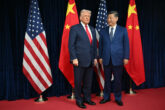June 18, 2019
Addressing America's Operational Shortfall in the Pacific
The Trump administration has made a number of strong statements about the need for the United States to do more to prepare for great power competition with China. Officials have effectively set the stage for 2019 as a year in which critical progress must occur with regard to implementing posture, budgets, and policies that counter Chinese efforts to displace the United States in the Western Pacific. Unfortunately, the scope and scale of Chinese efforts over the past 25 years diminished America’s influence in Asia, particularly its role in Southeast Asia, in such a way that current U.S. actions must have a sense of urgency if they are to succeed.
The 2018 National Defense Strategy clearly articulated the top priority the Trump administration placed on handling the challenges mounted by near-peer competitors. The budget deal agreed to last March reset the baseline for defense funding at 3.5 percent of GDP and provided two years of significantly increased funding over Fiscal Year (FY) 2017 levels. These efforts, along with other trade and policy actions by the Trump administration in 2018 and 2019, reflected a renewed concern for the economic and security threat China presents to the United States and its allies in the Asia-Pacific.
Recently, the Department of Defense released its new Indo-Pacific Strategy Report. The document represents an excellent discussion of the challenges the Pentagon faces and a cross-referencing of the ongoing procurement and posture changes in the works to address them. However, it does not fundamentally address the core operational issues the U.S. military faces, nor explain how it could reduce the risk in an acceptable time frame. The Defense Department and the administration should be proposing actions to demonstrate that the United States is committed to countering the threat posed by China in the Asia-Pacific and is willing to realign its force posture and service budgets to achieve this strategic objective. These posture actions whill emphasize U.S. efforts to both assure allies and partners and deter Chinese behavior in Southeast Asia; and, should deterrence fail, these actions will enhance America’s ability to rapidly defeat any Chinese provocations that occur.
Read the full article in War on the Rocks.
More from CNAS
-
Indo-Pacific Security / Energy, Economics & Security
How to Win the Economic War with ChinaTrump's approach to China has run aground, giving Beijing unprecedented advantage in the economic conflict....
By Edward Fishman & Julian Gewirtz
-
America’s Self-Loathing Is a Losing Hand
This article was originally published in The Washington Post.Around 10 years ago, the United States began a historic shift in its grand strategy toward China, abandoning the b...
By David Feith
-
Indo-Pacific Security / Energy, Economics & Security / Technology & National Security
Selling AI Chips Won’t Keep China Hooked on U.S. TechnologyU.S. policy should not rest on the illusion that selling chips can trap China inside the American tech ecosystem....
By Janet Egan
-
Will New Delhi-Beijing Move Beyond Friction Points? | Ex-White Official On India-China Reset
Prime Minister Narendra Modi on Friday said that India and China, as two major economies, must work together to bring stability to the global economic order. NDTV's Gaurie Dwi...
By Lisa Curtis




